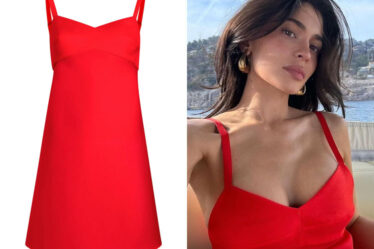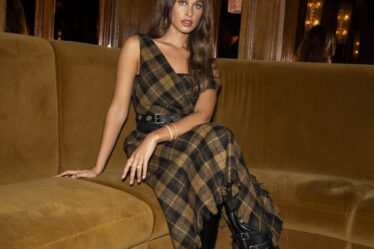MILAN — A shaky camera captures a young woman perusing a shelf of potato chips in an Italian bar-caffe, holding a baguette. Except it’s not a baguette; it’s a trompe l’oeil leather clutch with a loaf of bread inside it. The model tears off a chunk with her teeth. In another clip from Moschino’s most recent campaign, an overstuffed handbag dangles from the arm of a woman in a crisp overcoat as she taps a door code with red lacquered nails.
The blurry, slice-of-life clips are among the first images overseen by new Moschino creative director Adrian Appiolaza, teasing a new vision for the Italian house in which its surrealist, camp codes collide with real life — infusing the brand with youthful nonchalance.
Since joining the brand in January, Appiolaza has plunged deep into the archives of founder Franco Moschino, imbibing the designer’s vocabulary of clouds and polka dots, trench coats, turbans, trompe l’oeil neckties and chains of faux pearls. Moschino was certainly the most subversive, theatrical voice of Italy’s 1970s and 80s ready-to-wear boom, known for poking fun at the absurdities of fashion and pop culture while also fully participating in them.
But where Appiolaza’s long-serving predecessor Jeremy Scott dialled up the brand’s theatricality and irony to a new level with his high-voltage camp spectacles, Appiolaza is more interested in bringing those codes back to earth. Fashion-forward, surrealist silhouettes are increasingly interspersed with relaxed denim ensembles and easy T-shirt dresses.
“It was important to find the line between reality and theatricality. Without losing the theatrical, or rather what I would just call fun” Appiolaza told BoF at a meeting in Moschino’s studio the day before his sophomore outing at Milan’s womenswear week.

Moschino is still about making a statement — but it’s less about putting on a show than simply offering people ways to have fun and express themselves, he said. “As I’m rebuilding the teams [the studio had been based in Los Angeles under Scott] my aim is to really push the creativity and fashion … But so far, everything I’m proposing the teams are putting in the showroom to sell.”
Appiolaza studied in London at Central Saint Martins, then worked for Chloé and Marc Jacobs-era Louis Vuitton before embarking on a decade-long tenure as women’s ready-to-wear design director in Jonathan Anderson’s studio at Loewe. The designer arrived at Moschino under sombre circumstances: the Ferretti family that owns the brand had initially hired Gucci alum Davide Renne to succeed Scott, but Renne died suddenly just days after starting the job. By the time Appiolaza joined the brand, there were less than three weeks left to put together his Milan Fashion Week debut.
That didn’t stop Appiolaza from getting his point across when it came to honouring the brand’s heritage while ushering in a more relaxed, wearable era. “It helped that so many of Franco’s details are so durably delightful, but Appiolaza owned them, made them look fresh,” The Business of Fashion’s editor-at-large Tim Blanks wrote. “Appiolaza has a handle on eccentric realness,” Vogue Runway editor-in-chief Nicole Phelps echoed.
Former i-D editor-in-chief Alastair McKimm was also a fan. He reached out to Appiolaza after the first show, and has since been a styling consultant to the brand. “We’re trying to adapt my maximalism to his more minimalism, which I think is a good clash,” Appiolaza said. The designer has also teamed up with Nunzio del Prete, the Milanese stylist whose contemporary, grunge sprezzatura has helped make emerging label Magliano one of the city’s other hottest projects.
A large co-ed show during Milan menswear week in June introduced youthful touches of collegiate and skater-boy style for the guys, along with cheeky, surrealist showstoppers such as a goose-print dress styled with trompe l’oeil webbed-foot shoes.
Appiolaza’s new creative direction is hitting the market amid an industry-wide slowdown for luxury and designer fashion. Smaller labels in a state of transition have been hardest hit.
Shares in parent company Aeffe are down 28 percent year-to-date as Moschino’s sales fell 15 percent in the first half. “The unsatisfactory results of the first half of the year are the reflection of an extremely complex market situation,” the company told investors. “We are satisfied with the new stylistic course of the Moschino brand, which will allow us to reposition the brand with a new international appeal.”
In Milan Wednesday, Aeffe’s executive chairman Massimo Ferretti said he was confident in the brand’s prospects following an “incredible” response to Appiolaza’s new direction. “We needed to have a vision of the market inside the creativity,” Ferretti said. “Moschino is a very specific universe. Adrian understands what the market needs from the brand, knows how to translate the creativity in the world where we are today.”
The brand has attracted new stockists — including Dover Street Market’s edgy new Paris outpost and Joyce in Hong Kong — as well as opening a new retail corner at Galeries Lafayette in Paris and an accessories pop-up at Lotte in Seoul.
The company hopes to boost its accessories business by building momentum around Appiolaza’s new “Tie Me” bag, a top-handle style with a discreet logo, wrapped with a long strip of leather.

The brand’s women’s show Thursday will feature the bag in a spate of new colours and textures, as well as featuring partnerships with the late punk icon Judy Blame via the artist’s trust. A foil-covered top hat references an original piece covered by Blame covered in Moët Hennessy wrappers. A set of red macramé jewellery is printed on a trompe l’oeil T-shirt.
There’s also deconstructed flannel ensembles; exaggerated, punk twists on bourgeois tailoring; and garments made from pillowcases, embroidery samples, shoelaces. “The ordinary becomes extraordinary by just playing with it,” Appiolaza says.
Time will tell if the reality check — and the shift to playing with fashion, rather than poking fun at it — pays off.



